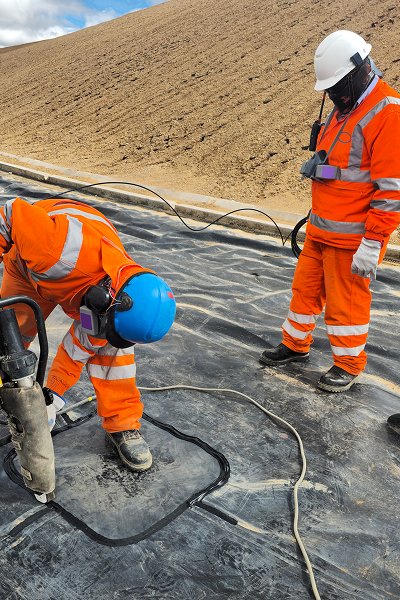Why is the welding machine so important for geomembrane projects?
The performance of the welding machine determines the quality and consistency of the weld
Compared with manual welding, modern geomembrane welding machines are equipped with temperature, speed, and pressure control systems, which can ensure that the welding process is stable and controllable and reduce human errors. The higher the control accuracy of the equipment, the better the strength, sealing and appearance consistency of the weld, and the higher the safety of the entire anti-seepage system.
Welding speed and efficiency directly affect the construction period and cost
A large-scale engineering project often requires welding of tens of thousands or even hundreds of thousands of meters of welds, and manual efficiency is far from meeting the construction period requirements. High-quality automatic welding machines can not only increase welding speed, but also reduce material waste and maintenance costs, saving a lot of manpower and time for the project.
Equipment adaptability and ease of operation are related to the stability of the construction team
Choosing the wrong welding equipment will not only affect the quality of the weld, but also may cause frequent equipment failures, increased difficulty in personnel training, and a surge in maintenance costs. Especially in extreme construction environments such as plateaus, high temperatures, low temperatures, and humidity, higher requirements are placed on the reliability of equipment.

Key factors affecting the selection of welding machines
Geomembrane type and thickness
HDPE, LDPE, LLDPE, PVC, EVA and other membrane materials respond differently to heat sources
Membrane thicknesses of 0.5mm, 0.75mm, 1.0mm, and 2.0mm have different requirements for equipment pressure and temperature
Project scenarios and working conditions
Are there slopes and facades
Is it a high altitude, low temperature or high temperature area
Large flat area vs. slope vs. corner structure
Welding strength and quality requirements
Is vacuum testing or non-destructive testing required
Is double weld/hollow channel design necessary
Construction progress and efficiency requirements
Automatic welding machines are suitable for high-speed laying
Is it necessary to have multiple devices for simultaneous construction
Operational convenience and maintenance cost
Are digital temperature control, automatic voltage regulation, intelligent fault diagnosis and other functions necessary
Is equipment maintenance convenient and spare parts universal


How to evaluate equipment performance parameters
Temperature adjustment range and control accuracy
Temperature control range: should cover 100℃–450℃, suitable for different membrane materials.
Temperature control accuracy: ±1–3℃ is optimal.
Display mode: whether it is equipped with a digital temperature display screen for real-time monitoring.
Whether it has over-temperature alarm and automatic shutdown functions.
Welding speed range and adjustment method
Speed adjustment range: 0.5–5 m/min is the optimal range, suitable for a variety of working conditions.
Speed control method: Digital stepless speed adjustment is better than manual knob.
Whether it has an automatic constant speed system to maintain a constant speed on slopes or windy areas.
Applicable film materials and thickness range
Applicable range: whether it is clearly marked that it supports HDPE, LLDPE, PVC, EVA, PP, etc.
Thickness support range: 0.5mm–2.5mm is the recommended general range.
Whether it supports double film layer docking (0.75mm + 0.75mm and other combinations).
Power adaptability and energy efficiency
Voltage support: 220V/110V/380V multi-voltage support is better than single voltage
Power range: ≥800W (hot air welding)/≥1500W (hot wedge welding) is the mainstream configuration
Energy efficiency: whether it supports energy-saving design, low standby energy consumption


Geomembrane welding machines can achieve strong, sealed, smooth and detectable welds, and can cope with complex working conditions with different membrane materials, different thicknesses, different terrains and climates. Wrong equipment selection is likely to cause leakage, project repairs, construction delays and even serious environmental pollution and legal risks.


